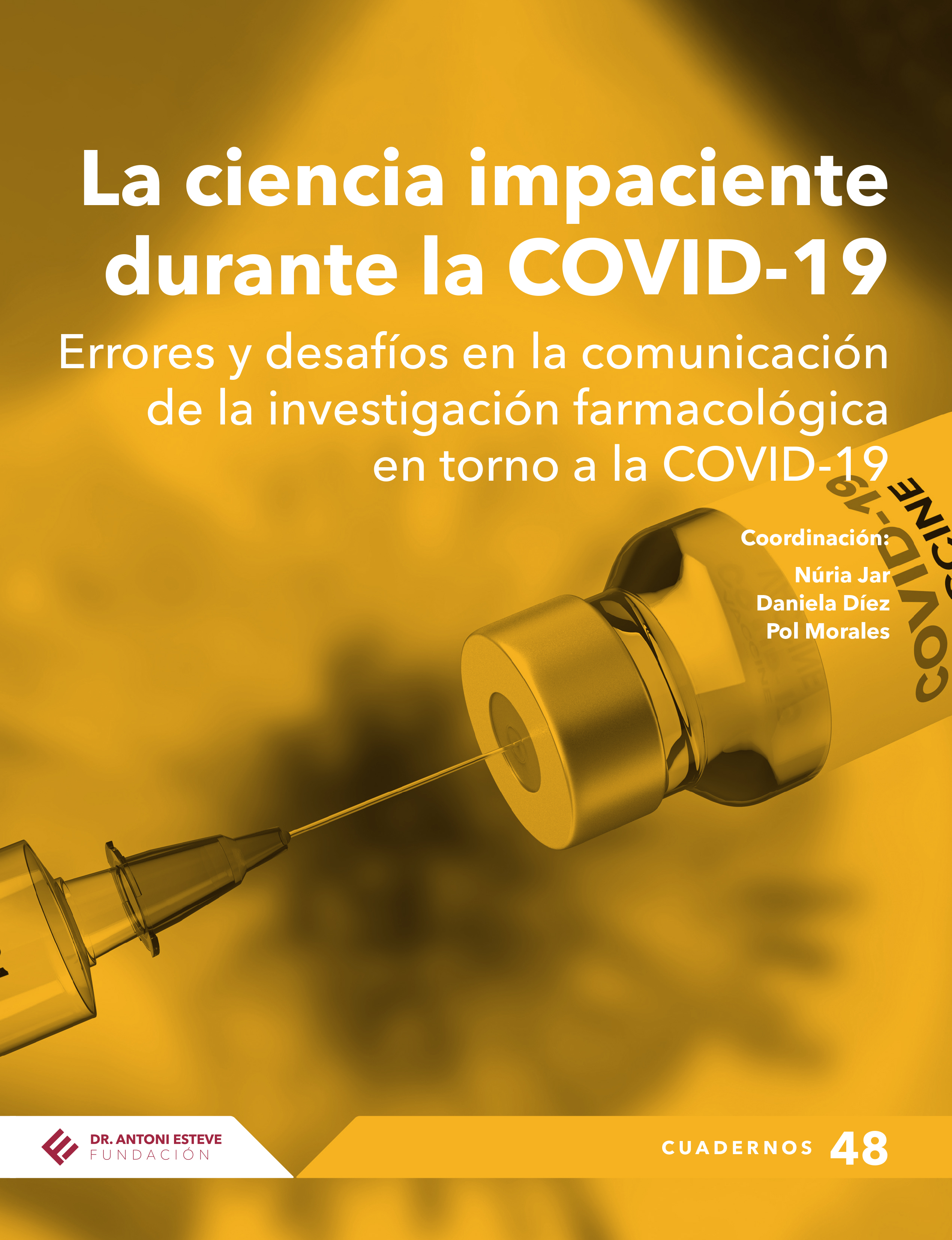
How have COVID-19 treatments and vaccines been reported in the midst of the news whirlwind and acceleration of science? Seven experts from the field of pharmacology, the publishing world and scientific journalism analyze the challenges and mistakes that have been made in communicating about drugs and vaccines during the current pandemic. They do it in The impatient science during COVID-19, a book that the Dr. Antoni Esteve Foundation has just published and that has been coordinated by the scientific journalist Núria Jar.
“Never before have we seen scientific knowledge advance live, being able to stream the results of different studies and clinical trials”, says Núria Jar in her chapter. “That is why I would like to vindicate communication as one more public health tool, in the same way that masks, hand washing, physical distance and indoor ventilation are. In a pandemic, citizen behavior is key to containing a virus and cutting the chains of transmission. For this, it is important to understand what a ‘bubble’ means, or what differentiates an ‘isolation’ from a ‘quarantine’ ”.
Magí Farré, Head of the Clinical Pharmacology Service at the Germans Trías i Pujol University Hospital in Badalona, takes stock of the research book on pharmacological treatments for COVID-19. “The need for a treatment led to the use of many drugs without evidence and the use of clinical results through retrospective studies loaded with biases, which in the end were almost always unsuitable,” explains the pharmacologist. However, she believes that pharmacological research has adapted to the challenge of the pandemic, strengthening the idea of the need for controlled clinical trials that evaluate new or repositioned treatments to determine their effectiveness.
For Javier Salas, a science journalist for El País, the big problem has been the misinformation that arose from the offices, “which was generated on purpose, by mistake or negligence, by some government officials, political leaders and even health authorities. Because their messages reached the general public, thanks to social networks, but also to conventional media. The role of journalists in this pandemic has been especially complicated, because we have not had to confront only the usual charlatans, but it has been a much more worrisome tsunami of misinformation because it came from above ”, says the journalist.
How has science managed to obtain a vaccine in record time? For Isabel Sola, from the Coronavirus Laboratory of the National Center for Biotechnology, previous scientific knowledge was available on other coronaviruses closely related to SARS-CoV-2, which have been essential in guiding the design of vaccine candidates. “On the other hand, the current state of science has made it possible to apply very innovative biotechnology and nanotechnology technologies to the development of vaccines to obtain new candidates with as yet unknown potential. Furthermore, the joint effort of research groups, pharmaceutical companies and regulatory bodies, together with an unprecedented investment, have had a synergistic effect to achieve the objective of the vaccine in a minimum time ”, explains the researcher.
For the scientific journalist Milagros Pérez Oliva, from El País, the first big mistake has been that the expected data on efficacy and safety have been released in press releases from the pharmaceutical companies themselves. “They have not only been communicated directly to the population through the media, without independent peer review or prior publication in scientific journals, but also through corporate notes that omitted relevant information in order to assess the real scope of the information. This is not exactly the best way to communicate science”, concludes Pérez Oliva.
According to PubMed, one of the main platforms for the search of scientific publications in the field of health sciences, between February 1 and November 30, 2020, more than 80,000 works related to COVID-19 were published, in its vast majority, in scientific journals. For the professor of preventive medicine and public health at the University of Valencia Ana María García, never before has a specific public health problem caused by science a care of similar dimensions, all over the world and in such a short time.
“Scientific journals have changed their editorial practices, and their leading role in the world of scientific communication has also been affected by the rapid dissemination of data, comments and criticism through social networks,” adds Ana María García. “It is worrying that the immediacy or speed of the publication of scientific observations, lacking filters or without sufficient sieves, leads to the dissemination of« worse »science, wrong results and conclusions due to unsolved methodological problems or even deliberately biased or false ”, concludes the expert.
For the scientific journalist Pampa García Molina, coordinator of the SINC agency, reporting during this pandemic has not been an easy task. “Perhaps this exercise of containment and responsibility in the face of noise has become, for many journalists – including myself – one of the most arduous tasks, which have required patience and a cool head in situations of news tension and fear of citizens in a very serious social and health crisis. It was important not to increase the noise and panic”, she reflects.
“The pandemic has exacerbated the needs and difficulties of our profession. It has exposed the seams of newsrooms where there are no journalists specializing in science and health; or they do exist, but they work precariously. She has also shown the good work of excellent journalists who have specialized in these issues on the fly, during the months of the pandemic, and they have done very well. It has exposed the enormous importance of professionalism when reporting on science, and of putting this priority before the impact of personal branding on social networks ”, concludes Pampa García Molina.